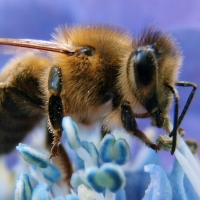U.S. Ninth Circuit Reverses EPA’s OK of Pesticide that Is Destroying Honeybees

When California registered the pesticide sulfoxaflor for use on a range of California crops in 2014 they were sued (pdf) in Alameda County Superior Court by Earthjustice on behalf of groups that alleged the insecticide was devastating the honeybee population nationwide.
Last week, a three-judge panel of the U.S. Ninth Circuit Court of Appeals in San Francisco, responding to a federal Earthjustice lawsuit, ruled (pdf) that the U.S. Environmental Protection Agency (EPA) erred when it approved the pesticide, and essentially ordered it off the market.
“Because the EPA’s decision to unconditionally register sulfoxaflor was based on flawed and limited data, we conclude that the unconditional approval was not supported by substantial evidence,” Judge Mary M. Schroeder wrote for the court.
The states, including California, will have to change their regulations to conform to the federal decision. Sulfoxaflor is in the family of pesticides called neonicotinoids that affect the central nervous system of insects, resulting in paralysis and death.
Honeybees, which are crucial to the California-dominated agricultural industry, have been dying out in unprecedented numbers since 2006. Land use and other factors are no doubt part of the problem, but pesticides have been one of the suspects from the beginning.
Around 1,300 bee keepers bring more than 1.2 million colonies to California to pollinate the state's almond trees annually, accounting for 75% of the bees used locally. The bees can then be used to pollinate dozens of other fruit, vegetable and field crops. California produces 82% of the world's almonds.
California’s approval (pdf) of sulfoxaflor noted that it would be used on grapes, potatoes and stone fruits. The Los Angeles Times said regulators had limited its use to lettuce, which are not frequented by honeybees. The use on lettuce was a special request to combat aphids.
The EPA admitted that it was aware that sulfoxaflor was “very highly toxic” to bees, but reasoned that rules for its application could be devised that would mitigate any harm. The court said the EPA had no basis for saying that.
Dow Agrosciences, maker of the insecticide, and the EPA argued to the court that although there were studies linking the product to bee deaths, they were not conclusive. That line of reasoning did not impress Judge Schroeder, who wrote:
“Neither logic nor precedent can sustain this position. We have previously held that an agency cannot rely on ambiguous studies as evidence of a conclusion that the studies do not support.”
Judge N. Randy Smith suggested in a concurring opinion that the EPA decision wasn’t just one of illogic or a misreading of precedent. He wrote:
“I am inclined to believe the EPA instead decided to register sulfoxaflor unconditionally in response to public pressure for the product and attempted to support its decision retroactively with studies it had previously found inadequate. Such action seems capricious.”
–Ken Broder
To Learn More:
9th Cir. Holds EPA Erred in Pesticide Approval (by Nick McCann, Courthouse News Service)
Court Rules Pesticide That’s Been Found to Harm Bees Is No Longer Approved in the U.S. (by Katie Valentine, ThinkProgress)
Court Overturns EPA’s Approval of Bee-Killing Pesticide (by Suzanne Potter, Public News Service)
Pollinator Stewardship Council et al v. U.S. Environmental Protection Agency (U.S. Ninth Circuit Court of Appeals) (pdf)
- Top Stories
- Controversies
- Where is the Money Going?
- California and the Nation
- Appointments and Resignations
- Unusual News
- Latest News
- California Forbids U.S. Immigration Agents from Pretending to be Police
- California Lawmakers Urged to Strip “Self-Dealing” Tax Board of Its Duties
- Big Oil’s Grip on California
- Santa Cruz Police See Homeland Security Betrayal in Use of Gang Roundup as Cover for Immigration Raid
- Oil Companies Face Deadline to Stop Polluting California Groundwater





